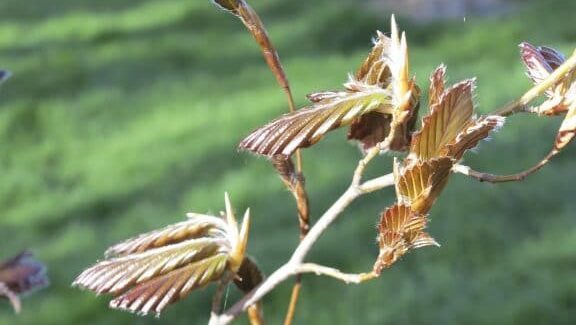
After a cool start to spring, leaves are beginning to open on roses, perennials, shrubs and trees. When new foliage is steadily appearing every day, it means the plants can process nutrients and manufacture their carbohydrate meal. It’s important to provide nutrients in mid-spring through early summer, when plants are eager to grow new roots and shoots. (You know plants are ready to grow when you notice new buds swelling in leaf axils.) Fertilizer applied in spring can bolster growth and enhance plant performance, but the same fertilizer applied in late summer can cause growth to be damaged by frost and compromise a plant’s winter hardiness.
Most often gardeners (and that includes myself) fertilize plants to produce a result, such as increased plant size, more flowers or bigger fruits, and we’re likely to use a fertilizer that packs a nutritional wallop. Concern for general health and well-being are less often the motivation for fertilizer meals. Because plants are constantly manufacturing their own foods through the process of photosynthesis, they don’t really require supplemental fertilizers. If we were feeding plants to promote their health, we would need only small amounts of nutrients provided in fertilizers with low analysis numbers.
Determining what fertilizer product to use begins with the nutrient analysis (always printed on the front of the product container). The numbers indicate the quantity of nitrogen, phosphorus and potassium plants receive from a fertilizer meal. Not all plant categories require the same amount of plant food. Woody and perennial plants need less fertilizer, because their annual incremental growth is retained from year to year. The branches and twigs of shrubs, and the increasing root mass and crown size of perennial plants are permanent (unless injured or diseased). Temporary plants like flowering summer annuals and many vegetables must produce all their growth in one season, and can make use of larger fertilizer meals.
A fertilizer like 20-20-20 is high in nutrient content and can be fed to summer annuals every three weeks to accelerate their growth and keep them fully in bloom until frost. But repeated feedings of that large an amount of nutrients to perennials would cause all kinds of problems like bud drop, burned roots, excessive foliage and fewer flowers. Permanent plants need only one spring feeding of a less potent fertilizer such as 4-12-8, which has less nitrogen for leafy growth and more phosphorus and potassium for roots, bud production and sturdy cell walls. Permanent plants aren’t fussy about the distribution of nutrients, and a balanced formula like 7-7-7 would work just as well. What’s important is that a fertilizer for permanent plants have all three of the analysis numbers lower than 15 to prevent a nutrient jolt or shock.
The illustrations on fertilizer boxes and bags indicate what plants they’re formulated for —for example, rose food will have a picture of roses and tomato food will have a picture of tomatoes. I usually have my own ideas of how large a meal I want to provide, and it tends to be less than the standard.
If there’s a box of water-soluble 20-20-20 on my garage shelf, I can use it at the full diluted strength for summer annuals, and then prepare another batch using only a half measurement of the fertilizer granules, resulting in a balanced 10-10-10 fertilizer for perennials. That’s an easy way to increase the versatility of a fertilizer, and make it useful for more than one kind of plant.








